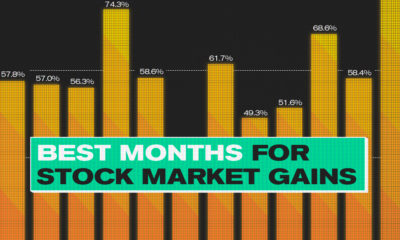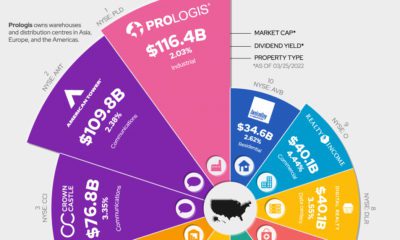For some, it’s his humble Omaha origins or his long-lasting obsession with Coca-Cola. For other people, it’s Buffett’s impeccable investing track record and extraordinary wealth that make a lasting impression. While these are all legitimate connections to make with the Buffett name, perhaps he is most synonymous with the discipline of value investing – the style and mindset Buffett has made famous over the decades.
The Warren Buffett Series
Part 2: Inside Buffett’s Brain
Today’s infographic provides a deep dive into Warren Buffett’s brain, and it explains everything about his investing philosophy, along with the framework he uses to evaluate potential opportunities. It’s the second part of the Warren Buffett Series, which we’ve done in partnership with finder.com, a personal finance site that helps people make better decisions – whether they want to jump on the cryptocurrency craze or follow Buffett’s more traditional path to financial success. Note: Stay tuned for future parts with our free mailing list. Warren Buffett’s investment philosophy is well-known. He famously focuses on the intrinsic value of companies, and he buys stocks when they are “on sale”. Buffett’s not afraid to accumulate big positions in companies he likes – and his favorite holding period is “forever”. While this formula may seem simple on paper, it’s extremely nuanced and complex in practice.
How Does Buffett’s Brain Work?
Warren Buffett has said that he borrows 85% of his investing style from Benjamin Graham, and 15% from Phil Fisher. Benjamin Graham: The godfather of value investing gave Buffett a framework for finding undervalued assets and companies. Phil Fisher: The famous growth investor showed Buffett the importance of investing with good management teams. According to writer Robert Hagstrom, Buffett applies these ideas by focusing on four key principles of investing:
- Analyze a stock as a business Have the priorities of a business owner and look the company from a long-term perspective. Is it increasing its intrinsic value? Would you want to own the entire company?
- Ensure a “margin of safety” Buffett considers “margin of safety” the three most important words in investing. In other words, does a company have more intrinsic value than book value?
- Manage a focused portfolio Concentrate on a few stocks that will provide above-average returns over time. Buffett suggests investors think of this as owning a “punch card” with just 20 investment choices that can be made over a lifetime.
- Protect yourself from Mr. Market Mr. Market can be speculative and emotional, and he should not be relied upon as a predictor of future prices. Instead, take advantage of Mr. Market periodically, whenever there is a fire sale.
Buffett’s Investment Criteria
Here are 12 key factors Warren Buffett considers when looking at potential opportunities:
- Simplicity Is the business easy to understand?
- Operating History Has the business been around for a long time, with a consistent operating history?
- Long-Term Prospects Is there reason to believe that the business will be able to sustain success in the long-term?
- Rational Decisions Is management wise when it comes to reinvesting earnings or returning profits to shareholders as dividends?
- Candidness Does the management team admit mistakes? Are they honest with shareholders?
- Resisting the “Institutional Imperative” Can the company resist temptations created by institutional dynamics, such as imitating peer companies, or resist changes in direction?
- Profit Margins Does the company have high profit margins?
- Return on Equity What is the return on equity (ROE) of the business?
- Owners Earnings What is the company’s ability to generate cash for shareholders, who are the residual owners? This is technically defined as free cash flow to equity (FCFE).
- One Dollar Premise For every dollar retained from net income, does the company create at least one dollar of market value?
- Intrinsic Value What is the value of the future owners’ earnings, discounted back to the present?
- Margin of Safety What’s the chance you’ll lose money on the stock, in the long run, if you buy it at today’s price? Or to sum all of these ideas up succinctly, here’s a quote from the man himself. – Warren Buffett
Other Notes
Part 3 of the Warren Buffett Series will be released in late February 2018. Credits: This infographic would not be possible without the great biographies done by Roger Lowenstein (Buffett: The Making of an American Capitalist) and Alice Schroeder (The Snowball), as well as numerous other sources cataloging Buffett’s life online.
on Last year, stock and bond returns tumbled after the Federal Reserve hiked interest rates at the fastest speed in 40 years. It was the first time in decades that both asset classes posted negative annual investment returns in tandem. Over four decades, this has happened 2.4% of the time across any 12-month rolling period. To look at how various stock and bond asset allocations have performed over history—and their broader correlations—the above graphic charts their best, worst, and average returns, using data from Vanguard.
How Has Asset Allocation Impacted Returns?
Based on data between 1926 and 2019, the table below looks at the spectrum of market returns of different asset allocations:
We can see that a portfolio made entirely of stocks returned 10.3% on average, the highest across all asset allocations. Of course, this came with wider return variance, hitting an annual low of -43% and a high of 54%.
A traditional 60/40 portfolio—which has lost its luster in recent years as low interest rates have led to lower bond returns—saw an average historical return of 8.8%. As interest rates have climbed in recent years, this may widen its appeal once again as bond returns may rise.
Meanwhile, a 100% bond portfolio averaged 5.3% in annual returns over the period. Bonds typically serve as a hedge against portfolio losses thanks to their typically negative historical correlation to stocks.
A Closer Look at Historical Correlations
To understand how 2022 was an outlier in terms of asset correlations we can look at the graphic below:
The last time stocks and bonds moved together in a negative direction was in 1969. At the time, inflation was accelerating and the Fed was hiking interest rates to cool rising costs. In fact, historically, when inflation surges, stocks and bonds have often moved in similar directions. Underscoring this divergence is real interest rate volatility. When real interest rates are a driving force in the market, as we have seen in the last year, it hurts both stock and bond returns. This is because higher interest rates can reduce the future cash flows of these investments. Adding another layer is the level of risk appetite among investors. When the economic outlook is uncertain and interest rate volatility is high, investors are more likely to take risk off their portfolios and demand higher returns for taking on higher risk. This can push down equity and bond prices. On the other hand, if the economic outlook is positive, investors may be willing to take on more risk, in turn potentially boosting equity prices.
Current Investment Returns in Context
Today, financial markets are seeing sharp swings as the ripple effects of higher interest rates are sinking in. For investors, historical data provides insight on long-term asset allocation trends. Over the last century, cycles of high interest rates have come and gone. Both equity and bond investment returns have been resilient for investors who stay the course.



















